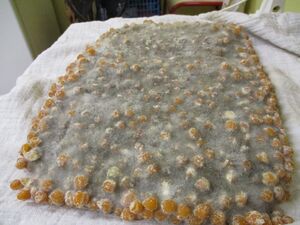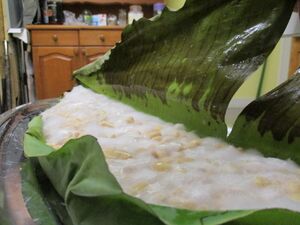Soybean fermentation mch2022: Difference between revisions
(Created page with "<<<Back to fhb at MCH2022 main page>>> [ To secure spot on this workshop please sign in here.] Image:Tempeh_cloth_overview_faa05092017.jpg|thumb|right|Temp...") |
No edit summary |
||
| Line 5: | Line 5: | ||
[[Image:Tempeh_cloth_overview_faa05092017.jpg|thumb|right|Tempeh made in cloth]] | [[Image:Tempeh_cloth_overview_faa05092017.jpg|thumb|right|Tempeh made in cloth]] | ||
[[Image:Tempeh_banana_leave_ready_1600_faa08092017.jpg|thumb|right|Tempeh in banana leave]] | [[Image:Tempeh_banana_leave_ready_1600_faa08092017.jpg|thumb|right|Tempeh in banana leave]] | ||
[[Image:Natto mixing faa19042021.jpeg|thumb|right|Mixing nattō]] | |||
[[Image:Tempeh_banana_leave_cut_close_up_1600_faa08092017.jpg|thumb|right|Tempeh cut close up]] | [[Image:Tempeh_banana_leave_cut_close_up_1600_faa08092017.jpg|thumb|right|Tempeh cut close up]] | ||
Revision as of 13:39, 21 June 2022
<<<Back to fhb at MCH2022 main page>>>
[ To secure spot on this workshop please sign in here.]
Workshop manual is shared here.
This workshop is an introduction to soybean fermentation. It will take you through the preparation of the soybeans or other legumes (most likely chickpeas), inoculation of the beans with the microbial culture and the subsequent harvesting and aging - your ferment should be ready for preparation and eating on the Day 3. We will do tempeh cultured by Rhizopus oligosporus which is nice and easy opening for beginners. However this time we will do also nattō, which for some is absolutely amazing ferment (and some hates it to the bone) and it is very hard and expensive to come across in Europe.
The diversity of the ferments which can be prepared from soybeans (and other legumes) is truly amazing, depending on the cultures/microbes being used and conditions/techniques applied . In this workshop we will go through the basic steps which will secure proper preparation of the chickpeas/soybeans as a substrate for the microbes to inoculate it with. Optimal fermentation conditions will be discussed and devices making it easy to establish them suggested (Experimental Incubator for example). We will be also harvesting/preparing the previously made tempeh and hopefully nattō and as usually tasting samples of the final products. The results of this workshop should be ready for tasting on Day 3 (48 hours of fermentation at 25-30°C is sufficient for tempeh, 24-48 hours at 42°C for nattō). We are going to provide the participants with adequate starter cultures for their experiments, at least for few first batches, you should however get your own starter for later experiments, more info below.
This workshop is based on donation at your will no one turned away for lack of funds. If you can afford to donate, please do, during the years I have found out that if people donate during the workshop between €5-15 per person, things go well for me and I can cover most of the expenses so I can keep coming to the events.
For the past three years or so we are using starter from Topcultures company based in Belgium. It works very well and it is well priced, for €20-30 you will have enough to play for a year or so I would say. However as mentioned above, part of the "package" is small dosage of the starter for you for few to several first batches.



